
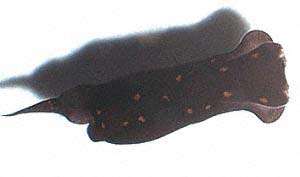
Chelidonura sandrana
Rudman, 1973
Order: CEPHALASPIDEA
Family: Aglajidae
DISTRIBUTION
Originally described from Tanzania, in East Africa, but I have also found this species on the Great Barrier Reef, Queensland.
PHOTO
Kunduchi Beach, Dar es Salaam, Tanzania, November 1973. Maximum length 17mm. UPPER: Common East African colour form with white markings. Note prominent sensory bristles on each side of the mouth. LOWER: uncommon East African form with only yellow spots. PHOTOS: Bill Rudman.
I originally found this species in large numbers crawling over fine coral sand in a shallow lagoon at Paje in Zanzibar in 1971. I was visiting Paje because Sir Charles Eliot, who published so much on East African nudibranchs, had a residence there when he was the British government representative there at the turn of the century. I had no suitable container for collecting so only managed to collect 4 specimens. They were crawling in an area densely covered with small flatworms, which first gave me the idea that flatworms were a likely food for Chelidonura, an idea recently confirmed by Sea Slug Forum participants. I later found it quite commonly in Dar es Salaam on mainland Tanzania. Most specimens had yellow and white markings. The yellow-spotted form was very rare.
Since finding a similarly shaped small species of Chelidonura in similar places on the Great Barrier Reef, but without the white "petals" around the yellow spots, I am inclined to think that C. sandrana may be synonymous with Chelidonura tsurugensis which was described from Japan. In both species the ventral surface of the animal is black, without the dorsal colour pattern.
As I named this species after my wife, I have been in no great hurry to synonymise it with Chelidonura tsurugensis but Bob Bolland's photo certainly suggests they are very similar.
The other alternative is that there are two species. One point of difference is that the two white patches on the front of the head in C. tsurugensis are absent in "typical" C. sandrana. White patches on the head are only present in specimens with only the yellow spots. This could suggest there are two species, C. tsurugensis with a wide distribution throughout the Indo-West Pacific, and C. sandrana restricted to the Indian Ocean. Any photos of "typical" C. sandrana from the Pacific would be of interest.
[Note added 9 Feb 2000]: Another name for this species is C. babai Gosliner, 1988, described from Aldabra Atoll in the Indian Ocean - see Terry Gosliner's message below.
Reference:
• Rudman, W.B. (1973) On some species of Chelidonura (Opisthobranchia: Aglajidae) from Zanzibar and Fiji. Zoological Journal of the Linnean Society, 52: 201-215.
Rudman, W.B., 1998 (October 27) Chelidonura sandrana Rudman, 1973. [In] Sea Slug Forum. Australian Museum, Sydney. Available from http://www.seaslugforum.net/find/chelsand
Related messages
Larvae of Chelidonura sandrana
November 20, 2006
From: Johannes Faber
Concerning message #7028:
Hi Mr. Revell,
I am working with the sea slug Chelidonura sandrana. I read that they feed the algae Isochrysis galbana and you have used it for your experiment as well. Where did you get the algae and do you have any experiences to feed them to the cephalaspid C. sandrana adult/larvae?
Locality: Lizard island, Queensland, Australia
Johannes Faber
johannes.faber@gmx.de
Faber, J., 2006 (Nov 20) Larvae of Chelidonura sandrana. [Message in] Sea Slug Forum. Australian Museum, Sydney. Available from http://www.seaslugforum.net/find/18409Dear Johannes,
I am not sure if Duncan will be reading the Forum regularly - it's possible he still uses the email address on his message which may be worth trying. Isochrysis galbana is one of the standard unicellular algae cultured for laboratory and aquarium studies, and often used for veliger larvae culture. I think seed cultures can be obtained from biological supply houses and possibly other labs. The problem with culturing veliger larvae is not just a food supply but the need to keep the culture free of harmful bacteria and other organisms which may attack the veligers. Another physical problem is the way veligers after often attracted to th light and consequently get caught in the surface film and die. We are pretty sure that all adult Chelidonura feed on small flatworms.
I would be interested to know what work you are doing at Lizard Island on Chelidonura sandrana. It is proving to be a popular research topic
Best wishes,
Bill Rudman
Colour form of Chelidonura sandrana
March 11, 2003
From: Gillian Elliott
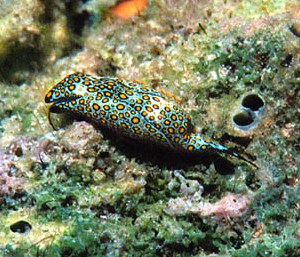
Dear Bill,
I found this Chelidonura crawling over the sand at a depth of 10m at Mantanani Island, Sabah, Malaysia. It was approximately 10mm in length.
Am I correct in identifying it as a Chelidonura flavomaculata?
I look forward to hearing from you,
Gillian Elliott
gillyelliott@yahoo.com
Elliott, G., 2003 (Mar 11) Colour form of Chelidonura sandrana. [Message in] Sea Slug Forum. Australian Museum, Sydney. Available from http://www.seaslugforum.net/find/9006Dear Gillian,
I am pretty sure this is a white colour form of Chelidonura sandrana. If you look at Nils Anthes' message from Lizard Island, Queensland, you will see a similarly coloured specimen, and my upper photo from Tanzania, on the species Fact Sheet shows how each yellow spot has a narrow ring of black separating it from the surrounding white patches and speckles. I am not sure I know of a species called Chelidonura flavomaculata.
Best wishes,
Bill Rudman
Chelidonura sandrana colour morphs
January 25, 2003
From: Nils Anthes
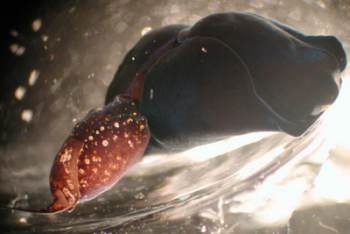
Hi Bill,
Following on from my earlier message here are photos of various colour 'morphs' of Chelidonura sandrana. The lower two photos show approximately the extremes of the range of colour patterns we found here, ranging from very pale, 'sandy' specimens to almost black ones with very few orange spots. Everything in between is present at Lizard Island.
The upper picture shows a typical C. sandrana mating with a large, black one. The black one lacks any kind of spots but in shape looks identical to the smaller animals.
Although we believe that this is still the same species, the pattern strikes and confuses a little bit... I am sending a separate message with a photo of the black animal which occurs in separate populations.
Kind regards
Nils
anthes@uni-muenster.de
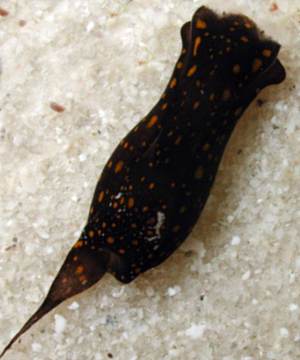
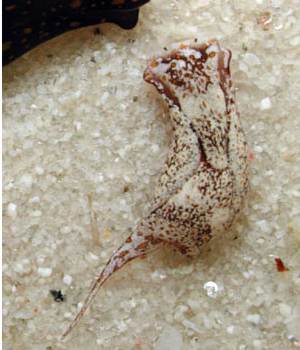
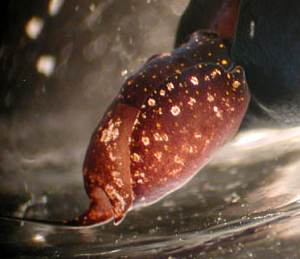
Thanks Nils,
I have a included a closeup of the 'typical' form from your 'mating' photo. As you can see in Lindsay Warren's photos all colour forms can be found in mating 'chains'.
It is certainly a large size difference. I realise that in crowded dishes it is quite easy to get animals to mate, but the way the small animal is 'mating' with the large black one in your photo is most unusual, The position and size of the penis and position of the vagina, make this an almost impossible position for mating to occur. But I guess with this size difference, perhaps it is the only way mating can occur. Lindsay Warren's photos show the usual position.
Best wishes,
Bill Rudman
Re: Chelidonura sandrana - feeding
January 18, 2003
From: Nils Anthes
Dear Bill,
Thanks for your comments on the Forum concerning food of C. sandrana. We are already on Lizard island, and C. sandrana occurs in almost incredible numbers. Along the beaches many thousands can currently be found. This is of course extremely helpful for our whole project: the slug named after your wife turns out to be a real "beauty" for our investigations!!!
An interesting phenomenon that we find here is that C. sandrana seems to segregate spatially: many pale and relatively small, but sexually mature individuals can be found at one patch. Only 50 meters further down the beach almost purely black individuals, that are on average much larger, can be found. First we were sure to see yet another species of Chelidonura, but in the meantime we are more or less convinced that both are C. sandrana. As I don't think that the species has a 2/year life-cycle, they must all belong to the same generation. Is there anything known that sea slugs can
drastically change their coloration with age?
Concerning coloration, we find all intermediate patterns, ranging from completely blackish (bluish in direct light), over blackish with very few orange spots (like C. punctata), to almost whitish ones with few dark spots. If you are interested, we could send you a whole array of pictures taken in the lab of different colour morphs (and also egg clutches) on a CD-rom at some stage. Concerning the food, I found the information on C. varians very promising. Possibly the flatworms that seem to be a big problem for aquariists could turn out to be a fantastic food source for our purpose. We'll try to get in touch
with these guys.
Anyway, your Forum is really a great deal and has already provided much valuable information for our research project.
Cheers
Nils
anthes@uni-muenster.de
Anthes, N., 2003 (Jan 18) Re: Chelidonura sandrana - feeding. [Message in] Sea Slug Forum. Australian Museum, Sydney. Available from http://www.seaslugforum.net/find/8940Dear Nils,
Glad to hear that you are on Lizard and are having success with C. sandrana. You're very lucky because some times you won't find any. I look forward to photos showing colour variation. Concerning flatworms. Another place to look is sponge and soft coral colonies - sometimes they can be infested with huge numbers of little acoel flatworms - which is probably how they get into aquaria.
Anyway good luck with your project, and thanks for keeping in touch - its nice to have some 'continuing stories'
Best wishes,
Bill Rudman
Chelidonura sandrana - feeding in lab
January 15, 2003
From: Nils Anthes
Dear collegues,
We currently start a project that is aimed at describing mating behaviour and understanding mating conflicts in Opisthobranch sea slugs. For that purpose, we intend to do an array of behavioural observations in the lab, which means that we have to keep animals of the familiy Aglajidae in the lab for a while, and release them after observations to the place of collection. We just happened to find a suitable species, Chelidonura sandrana, that appears to be reasonably common at Lizard Island (North Queensland, Australia). The crucial point at the moment is how to keep the slugs 'happy', thus how to provide suitable food. Does anybody know what C. sandrana feeds on in its natural habitat? We found some comments that they might feed on flatworms, but that didn't seem to be proven, yet. For us it would be even more convenient to find a commercially available food source. People keeping sea slugs in aquaria might know, could anybody give us a hint whom we could contact for that purpose?
Any information is valuable, also if you know other places where you found the species in high abundance.
Kind regards
Nils
anthes@uni-muenster.de
Dear Nils,
As I said in response to your earlier message, the little species, such as C. sandrana are often very abundant, but unfortunately their presence is unreliable. If you are planning a trip to the Australian Museum's research station at Lizard Island, I hope the Chelidonura will be obliging. Concerning feeding in Chelidonura. Most of the discussion of feeding in Chelidonura is on the C. varians page. You will need to scroll down the page and look at the earlier messages. Basically we don't have direct observations of feeding in most species but from the few observations we do have it is probable that they all feed on flatworms. Whenever I have found large numbers of these 'small' species on sand flats they are accompanied by populations of similarly sized flatworms so you would be able to collect them together. I am not sure how easy it is to keep the flatworms in captivity so if you are planning to do your experiments at the lab, it might be better to regularly collect fresh flatworms from the field during the course of your experiments.
I will be intersted to hear of anyone else's comments on the topic.
Good luck with your project,
Bill Rudman
Re: Chelidonura? from the Philippines
December 3, 2002
From: Erwin Koehler
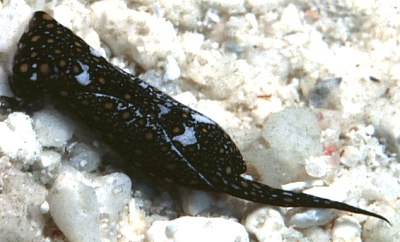
Dear Bill,
You are right. I scanned the photo in reverse.
Erwin
Erwin@medslugs.de
Thanks Erwin,
That definitely removes my doubts about it being C. sandrana.
Cheers,
Bill
Chelidonura? from the Philippines
December 2, 2002
From: Erwin Köhler
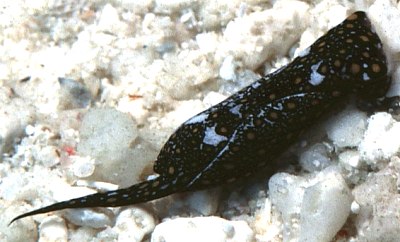
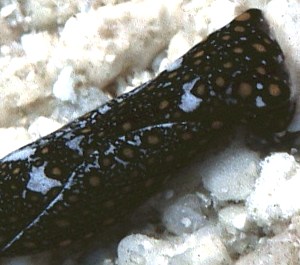
Dear Bill,
Here is one more picture ny Georg Heinze [Georg.Heinze@t-online.de] from the Philippines, Cabilao Island, Divesite "Lighthouse"
Size: 5mm
Depth: 3m
Date: May 2002
Erwin
erwin@medslugs.de
Köhler, E., 2002 (Dec 2) Chelidonura? from the Philippines. [Message in] Sea Slug Forum. Australian Museum, Sydney. Available from http://www.seaslugforum.net/find/8533Thanks Erwin,
I am pretty sure this is Chelidonura sandrana but the relative lengths of the 'tails' is a problem. In this photo the right 'tail' is long and well-developed while the left one is a small stump. In C. sandrana the opposite occurs. One possibility is that the photo was scanned in reverse. Can you check please?
Thanks,
Bill
Chel. sandrana & C. tsurugensis mating
March 29, 2001
From: Lindsay Warren
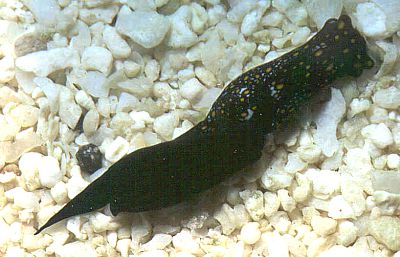

Dear Bill
I thought you might be interested in the attached photo of Chelidonura sandrana and C. tsurugensis mating. The almost black specimen does in fact have 3 dark orange but rather inconspicuous spots which are hard to see in the scan. After cavorting around for a while in this mating formation they then swopped around so that the almost black specimen mated with C. sandrana. I found them at 7am on 15 October 2000 at low tide in about 3 inches of water on the sand and seagrass flats of Pulau Hoga, Tukang Besi Archipelago, SE. Sulawesi. Size range: 12-15 mm. [Operation Wallacea]
Some time ago I sent you photos of other specimens of C. sandrana / C.
tsurugensis and commented about observing them mating but did not have any photos of this. I have checked through the list of preserved specimens and these have all been kept in separate jars so it would be possible to check them individually.
All the best
Lindsay Warren
alldcl@compuserve.com
Warren, L., 2001 (Mar 29) Chel. sandrana & C. tsurugensis mating. [Message in] Sea Slug Forum. Australian Museum, Sydney. Available from http://www.seaslugforum.net/find/4056Dear Lindsay,
Thanks for the great photos. I have no problem with Chelidonura sandrana ranging in colour from its full floral pattern to pure black. The problem is to determine whether Chelidonura tsurugensis is the same species. As you will see from earlier correspondence it would be nice to know a little more about the colour range and the anatomy of 'typical' C. tsurugensis from Japan.
The problem is that 'lumping' or synonymising two species into one is a more difficult task than describing a new species. If I lump C. sandrana and C. tsurugensis together now and later find that its anatomy is different, then it will be more confusing than leaving them separate for a little while longer. At present 'C. sandrana' exhibits its wide colour variety throughout its wide geographic range while 'C. tsurugensis' seems to only have the yellow-spotted colour pattern in Japan. if they are both the same species I would expect that the full range of colour variation, or at east part of it, would be exhibited by Japanese specimens. Hopefully someone from Japan will be able to give us some more colour information, if not specimens.
Best wishes,
Bill Rudman.
Re: Chelidonura sandrana complex
February 9, 2000
From: Terry Gosliner
Dear Bill,
I agree that the two species depicted in Lindsay Warrens' message are distinct. Also, Bob Bolland has a picture of C. tsurugensis on his web site at: http://www.rfbolland.com/okislugs/cheltsur.html
It usually has opaque white semi-circles just behind the eyes and may be distinct from C. sandrana. The other species to mention is C. babai that I described from Aldabra Atoll in the Indian Ocean. I am sure that it is a synonym of C. sandrana having seen more specimens from several localities. Best,
Terry
tgosline@calacademy.org
Gosliner, T., 2000 (Feb 9) Re: Chelidonura sandrana complex. [Message in] Sea Slug Forum. Australian Museum, Sydney. Available from http://www.seaslugforum.net/find/1879Dear Terry,
Thanks for the comments. The one photo on the Forum of C. tsurugensis shows the white semi-circles quite clearly. It would be nice to get some more photos from Japan of this colour group to see if there are any consistent differences.
Best wishes,
Bill Rudman.
Chelidonura sandrana & look-alikes
February 5, 2000
From: Lindsay Warren
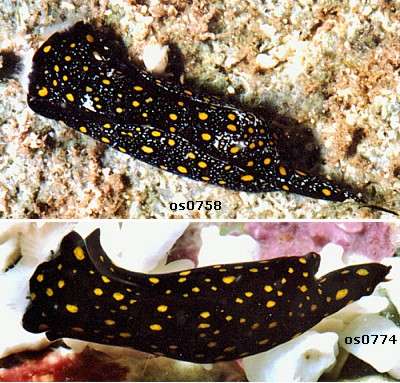
Dear Bill
Many thanks for your swift response to the queries on the Polycera and Hypselodoris.
Here are some photos of the Chelidonura sandrana / tsurugensis problem group.
I found them together during the afternoon in the same shallow sand flat area on the shores of Pulau Hoga in the Tukang Besi [Indonesia - Operation Wallacea] which features a mixture of seagrass and Halimeda. Water depth was appoximately 2-3 ft deep but this area does become completely exposed at low tide. Some were mating when collected but I couldn't see which were or were not at the time.
However once in holding dishes back at our base they proceeded to form mating chains with the multi yellow spotted, sparsely orange spotted, yellow and white spotted and completely black individuals all together.
Attached are:
OS0758 - 14 mm
OS0774 - 10 mm.
OS0777 which is black with a few orange spots, L: 12 mm
OS0776 which is completely black, bar the head sensory bristle area, L: 11mm
Photos: Lindsay Warren.
Having looked at your entries for C. sandrana and C. tsurugensis our findings would seem to imply that they are different forms of the same species. I realise that you would need the specimens to confirm this and am working on getting them to you if you would like.
Looking forward to hearing your thoughts on the above.
All the best
Lindsay Warren
100014.2112@compuserve.com
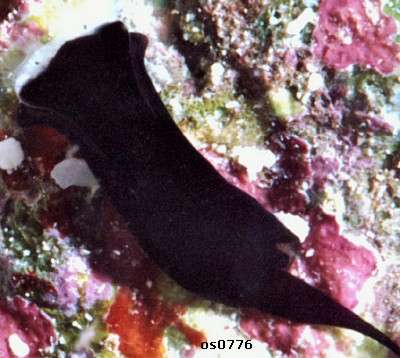
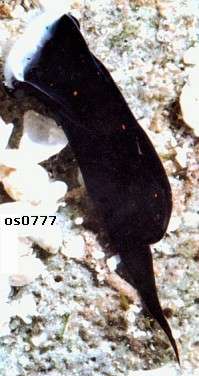
Dear Lindsay,
Thanks for the photos. I certainly have found
Chelidonura sandrana ranging in colour from the very colourful to pure black. However I think your bottom two photos (0776, 0777) are probably a second species which I have in the list as Chelidonura sp. 1.. The only obvious difference is the distinctive white band across the front of the head.
I realise it is now too late to go back and see if the white banded ones joined in the mating chains with the non-banded ones, but it is certainly something worth a look next time you comne across large populations again. I have found mixed populations of these smaller species in Tanzania and east Australia so being found together, I'm afraid only confuses the issue.
I think you are right in suggesting C. sandrana and C. tsurugensis are the same but it would be good to get some photographs of Japanese species with yellow spots for comparison.
I would be interested in having a look at the specimens but if the white banded ones have not been separated from the others it may be difficult to sort out which are which.
Best wishes,
Bill Rudman.
